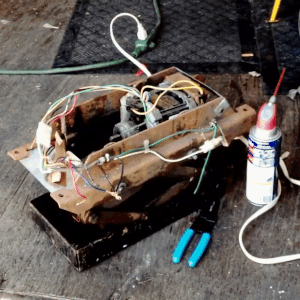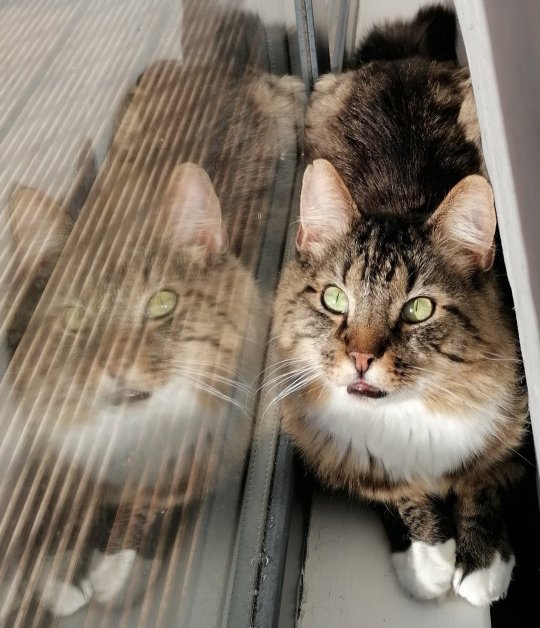#salvage
Text
Salvage by MuffinLance
I completed this baby back in October early November it was painfully fun, lol. Shoutout to @no-name-publishing for sharing their typeset with me!


Below the line, there is more information and photos on this bind!
The foiling took about 8-9 hours or so. There was a lot of trial and error, and I ruined about 3 books worth of bookcloth. I ran through all my heat reactive silver foil (neverforget✊️)before I was able to compelte it. I used foil I got from a bindery that is closing down, I used my new cameo, and the memory keepers heat foil quills.


I was originally going to use The Great Wave off Kanagawa as my cover art, but my friends talked me out of it, and I'm glad since, had I not listened, it may have taken longer. The sound of the cameo working will haunt my nightmares. My spouse was dreading their life choices. "Why did I buy her the machine from hell?" Cause you love me, my sweet honeybooboo, that's why.
I used 28lb paper for this puppy, my printer was such a good boy and printed it out without a single issue (bless you babe I will thank you first when I get a trophy one of these days) but after I folded it it was like 3 inches wide and I got so scared for my life.



I used remie band and linen thread (only the best for you, my precious), I made headbands with the bookcloth and l2mm leather core, and I used glue and kozo paper to strengthen the rounded spine.
Rounding and backing almost made me cry, but I had DAS there with me. Also, shoutout to my friend's cousin for the backing and routing boards and Jim with ABE for the wonderful laying press.

The endpapers are from De Milo Design. They are handmade, and I got them at a local faire. They are beautiful!

The bookcloth is from BookcraftSupplyCo in CA!
If you would like to learn more about bookbinding, consider joining @renegadepublishing

#bookbinding#handmade#renegadepub#atla zuko#atla#avatar the last airbender#fanfic#fanbinding#zuko#prince zuko#salvage#muffinlance#salvage by MuffinLance#ao3 fanfic
863 notes
·
View notes
Photo

Zuko and the masseurs be talking mad shit about certain high ranking Fire Nation military officials
(Based on a scene from @muffinlance’s Salvage that has unfailingly made me laugh every time I read it)
+Bonus Content


[Text in cursive because I always think mine is legible but you never know: Come collect your child. - Madame Sun]
[Text behind Hakoda: I am not going to murder this boy I have put too much work into keeping him alive]
#'you went to brothels. to gossip'#iconic behavior honestly#don't mind me I'm just rereading my favorite fics for fanart material#atla#avatar the last airbender#atla fanart#zuko#hakoda#bato#salvage#em draws#fanart of a fanfic#also I just realized I swear in like. all my comics#sorry y'all adfhdhsdfd#I will not lie I drew this while listening to the SIX soundtrack#for some reason. it vibed
3K notes
·
View notes
Text
Isopuppy's got legs for DAYS


Just need to get the top carapace on and write up the tutorial, and y'all can make your own Good Dog.
My baby spent most of the morning crawl-chasing me around, desperately pointing at the pupper to be allowed a hug (which she was finally granted just before nap time when I got the back seam closed, and she hugged it So Hard, then gummed those antennae real good). Toddler is demanding he be allowed to sleep with it tonight. So isopups are VERY snugglable, is what I'm saying.
#I love that white fabric now that it's all sewn up#that white fabric was THE BANE OF MY EXISTENCE while working with it#Had to get out a vacuum to deal with how much it was shedding#Had to literally have a dedicated outfit to sacrifice to the shedding that I changed in and out of before approaching that fabric#Had to WEAR A MASK at the sewing machine to keep it out of my mouth#There are people in a fabric factory somewhere dying of Faux Fur Lung there's no way there aren't#Anyway looking forward to the shell!#The non-shedding shell!#Salvage#The amazing isopuppy#avatar the last airbender#atla#Sewing
201 notes
·
View notes
Text
I just read all of @muffinlance 's fic "Salvage" in one day and it gave me the inspo to FINALLY make anothe rpiece I actually really liked lol

I so need to draw more atla stuff bc that show lives rent free in my mind
#atla#avatar the last airbender#zuko#atla zuko#atla au#salvage#salvage fic#fic art#atla fanart#avatar fanart
196 notes
·
View notes
Text
Fanbinding “Salvage”

My adventure in binding Salvage by MuffinLance and a second one for her has begun!
432 notes
·
View notes
Text
I absolutely adore Hakodad fics because I feel like the thought process is basically “what if Zuko had another father figure and three more uncles and two additional siblings and also a cute emotional support animal because our baby deserves it?”
#atla#avatar: the last airbender#zuko#hakoda#hakodad#muffinlance#salvage#ocs#found family#IS AMAZING#GIVE ZUKO A GIGANTIC FAMILY THAT LOVES HIM
831 notes
·
View notes
Text

The rescue bots zine gave me nostalgia
#transformers#transformers rescue bots#rescue bots#rescue bots au#catformers#heatwave#chase#boulder#tfrb blades#hightide#quickshadow#blurr#salvage#ma stuff#my art#maccadam#cat#tfrb#tfrb heatwave#tfrb boulder#tfrb chase
127 notes
·
View notes
Text
I have no idea if anyone else has thought of this, but I imagine that Salvage's reactions to learning about the Island of Misfit Technology would be:

72 notes
·
View notes
Text
This is the first part of a long-form piece about a robot and a giant computer. I expect it to take 3-5 parts to finish in a state I'm happy with. It will contain adult topics, overt sexuality, blatant robotfuckery, toxic lesbians, unbalanced power dynamics, wireplay, and lots of other things that may be triggering or make you uncomfy. Be aware before reading that while I'm emphasizing worldbuilding, at the end of the day this is gay robot smut.
Salvage - 01
Time inside - 00D/00H/00M
Levels deep - 01
Your feet hit the floor with an echoing clang as you drop the few yards down into the access hatch. You stare into the blackness for a moment as your cameras adjust to the lack of light, small LED points in the hallway glowing brighter by comparison as the rest of your vision lights up. You glance back up the hatch at the giant roll of auxiliary cable you've set up to leech from the structure's solar paneling, plugging the end of the wire into your upper back and giving it a firm pull to make sure it will unspool properly. It does. You invested in the best on the market, and even if it takes you weeks to get to what you need you shouldn't have to worry about power.
The site is a centuries-old computation soul, built during the ninth conflict as a safeguard against any unforseen threats. It was machines like this which ultimately won the war and led the corporation to global dominance, but they haven't exactly been rewarded for it. Dozens of the city-sized structures now sit abandoned and restricted, looming forgotten over the scrap fields they once protected.
Unlike the rest of society, you haven't forgotten them. Though they're from long before your time, you're connected to them in a way few other bots are- You're a late activation, brought into existence a few decades ago, one of just a few old wartime reserve models powered on for the first time to meet the demand of a labor shortage. Aside from less than a hundred other late activations, either maintenence drones or combat units like yourself, these old computational souls are the only real family you have left. It's why you're here at all, both because your body is permitted to be here without setting off the alarms, and because your obsolete frame is failing without the parts that exist nowhere else.
A few years ago, your battery life allowed you to function unplugged for weeks at a time. The last time you tried to operate without an external power source, you didn't even make it a few hours. A battery canister from the computer soul should fix that, though. The worn manual you were given on activation has taught you that it's an easy fix, and a single non-faulty canister should keep you going for the entirety of the conceivable future, it's just a matter of getting one. You tug at the cable, and it slithers along the ground behind you as you march forward into the dark.
For a place this old, the upper decks are shockingly well-maintained. You're sure they're not sterile, but they're about as close as a place like this could get. Whichever soul this facility maintains, they're exceptionally diligent about flushing pests and unwanted growth from their halls. Your heels click against the reflective metal flooring as you make your way through the seemingly endless halls of clean white and grey, passing rooms where maintenence drones once stayed and the occasional whoosh of a colossal ventilation column.
A thin survey arm drops from the ceiling, structure panels silently parting and closing in a wave around it to make way for it as it zips down the hallway to take stock of you, twin lenses fixed intently on your body as you give it a nervous wave. You shouldn't be perceived as a threat, but it's still not comforting to imagine how that might change for a hyperintelligent being left alone for hundreds of years. If YOU were in its position, seeing a light-framed combat unit aimlessly making her way through your hallways, you probably wouldn't be too thrilled.
The arm takes a last look at you and retracts back up into the ceiling, just as you stop at the central stairwell. Even though it's gone, it's safe to assume you're always being watched from this point forward. You try to ignore that feeling as you lean into the stairwell, making sure its structure hasn't degraded. It should be able to take you all the way down to the soul's core systems, where you'd find the thousands of fresh battery canisters storing the energy it pulls from the sun. You grip your cable with both hands to steady yourself, and begin your descent.
#robophilia#robotfucker#computer fucker#wireplay#robot yuri#robot4robot#pov#ns4w#longer form#salvage
77 notes
·
View notes
Text




Chica's Voicebox? Monty's Claws? Nah, Salvage has a better way to get through those pesky gates.
#fnaf oc#salvage#my ocs#fnaf gregory#fnaf sb gregory#fnaf sb oc#box art#more with the idea of salvage actually helping gregory throughout the night instead of hiding away in his attraction all night lol
241 notes
·
View notes
Text



tomsepe on ig | source
#talos gifs#stim gifs#stim#robot stim#robotics#robotcore#scrap metal#salvage#rust#hands free#mechanical#brown#black#grey#gray#wd-40#tinkercore#gif ids#id in alt
148 notes
·
View notes
Text


I'm glad Salvage has learned to co-exist with his reflection.
332 notes
·
View notes
Video
youtube
Set in a crumbling world similar to earth, Salvage Union by Leyline Press has you playing as a group of salvagers who live upon a huge Mech known as a Union Crawler which houses your entire community. As you eke out survival by scouring the wastelands for salvage in your Mechs, you’ll tackle the denizens of the wastes, whether that's bands of wastelanders, terrifying bio-titans, alien constructs and the powerful Corpos. Will you find enough salvage to survive in the wastes or fall prey to its many dangers?
73 notes
·
View notes
Text
Him's shell!

Just needs eyes and a nose now!
#Salvage#The amazing isopuppy#avatar the last airbender#atla#Very much enjoying my decision to put pipe cleaners in the antennae playing with them is very satisfying
183 notes
·
View notes
Text
The Salvage Economy in Your Local Area (And Why You Should Use It)
A salvage economy is an economic system that incentivizes the use of existing ("used") materials over the use of virgin ("new") materials to create products and generate income. They are more circular economies, where profits are more equitably shared, waste is reduced, and items have continuing value beyond a single consumer.
Let’s give the example of a piece of clothing. In a mainstream economy, raw materials would be grown (in the case of cotton/linin) or mined (in the case of something like polyester). They would then be manufactured (a water- and energy-intensive process), shipped to a store (another energy-intensive process) and sold for a profit. Once the end consumer was finished with the item, they would throw it away, losing their investment entirely, as well as losing the material and energy investment in the production of the product. Depending on the disposal method, the item would either go to a landfill (which has a limited amount of space) or burned (which releases the remains into the atmosphere where it can be a danger to human health and the natural environment- even with the most stringent of filters/re-burners).
In a salvage economy, however, the piece of clothing is diverted at the point of the first consumer no longer wanting it. It may be donated or sold to a thrift/consignment shop (where the person may get a small return on their initial investment). It could then be re-purchased by someone else repeatedly until it was no longer in a decent enough shape to be re-sold, then it would be sold to a re-processing facility, where the material itself could be deconstructed, re-woven, and returned back into that cycle (energy intensive as well, but less so than creating a garment from new materials). Everyone gets a small cut of the money involved in the item.
If the material was too damaged to continue in this cycle in a meaningful/economical way, and it needed to be disposed of, it could be added to building materials like concrete (ideal for things like polyester, for which other disposal methods would be environmentally damaging), composted (cotton/linin) to create biogas (heat/energy/cooking fuel), or burned for heat/energy (same problems as burning just to get rid of it, but at least you get energy from it, and you’re displacing some of the fossil fuels that would otherwise have to be mined just to burn for energy)*.
Salvage economies exist in parallel with more mainstream economies throughout the world, with varying levels of accessibility and cultural acceptance based on a person’s location, generation, and background. You’ve probably shopped at a “thrift” or consignment store or bought something on Craigslist or Facebook/Amazon Marketplace- this is participating in a salvage economy. But it goes deeper than that.
Culturally in the US, salvage has traditionally been seen as a cheaper second-best option if you can’t afford something new. However, in younger generations and as new items become harder to find and of lower quality, older items are becoming more desirable, and purchasing pressure is shifting, if only a little bit. While I am no economist (my highest degree is in environmental health science) I also think that as the scales start to tip to raw materials becoming less viable economically, companies will look at alternatives, and those alternatives will be existing materials.
I’m not here positing that we should abandon mainstream economies entirely. People will always want new things and be willing to pay for them. But we have a problem of too much trash and too few (and too expensive) raw materials, which create both pollution and shortages** (a problem that has been increasingly in the spotlight in recent years). And I believe that over the next few decades, the pressure (both from market demand and difficulty/expense creating/mining raw materials) will begin to shift, and with it, if you believe traditional economic theory, so too will companies looking to maintain profits. CEO’s gotta eat, (and purchase his 14th yacht), you know.
But I am here saying that you can start putting this pressure on corporations early. Avoid the rush, as they say- before shortages mean everyone turns to the salvage economy all at once with not enough infrastructure to support them. Here are some ways you can participate and build up that infrastructure:
Borrow or rent things you don’t use regularly
Hardware stores rent tools/machines
Look into tool exchanges in your area
Libraries for books (eLibraries like Libby are great if you can’t go to an in-person one, especially if you like audiobooks)
Libraries for toys/games/kits/electronics
Industrial kitchen rentals if you preserve or sell food in moderate quantities
Buy as much as you can used:
Need clothing and home-goods? Thrift stores like goodwill and consignment shops are great at this.
Some thrift shops have a fabric or yarn section if you have/want the skills to knit/sew your own clothing. I’ve gotten some excellent quality wools from Goodwill for super cheap.
Need building materials or furniture? Salvage yards run by demolition companies and charities like Habitat for Humanity ReStore have your back.
Pull-A-Part for car/engine parts
Need books, textbooks, physical media, really specific tools/items, etc? Facebook/Amazon Marketplace, Craigslist, eBay, Thrift Books, etc…
If you can’t get it used, at least save it from a landfill:
Shop for clothing/ home goods/furniture/food at overstock and “damaged goods” stores like Marshalls, Ollie’s, Gabe’s, Rose’s, local wholesale stores and the like.
Look into salvage grocery stores. Some are run by charities and specifically serve low-income clientele, but many are open to the public (especially in areas with high Amish populations). These stores buy overstock, expired (doesn’t mean bad), and food with damaged packaging in bulk and sell it for an extreme discount (like 90% off). Some even have frozen, refrigerated, and fresh sections.
Craigslist sometimes have people advertising fruit trees in their yards that are a nuisance to them d/t falling fruit, and want someone to come collect it
If you already have something, but it broke, try to get it fixed instead of replacing it. Look into:
Appliance repair places are still a thing
Electronics repair and referb places
Repair cafes (events where people with repair skills, people with tools, and people with things that need to be repaired can meet)
Mending circles and learning to mend and alter clothing yourself
Tailor/clothing repair shops
Watch/jewelry repair shops
Shoe repair shops
Car repair places (it’s like I’ve always said- the best car for the environment is the one you’re currently driving, especially if you keep getting it maintained and fixed appropriately as needed, but even if you don’t, it’s better than creating demand for something new)
Gardening! (look at it as making something you have or have access to (land/a yard) into something you need (food))
Most of these are cheaper options, some of them aren’t, but it’s great to create a list of resources in your local area as you find them- that way you’ll be less tempted to go straight to Target for a new item.
Additionally, with the exceptions of a few chains and online resources, many of the “salvage” stores are small, local businesses. And you want these to thrive, both to stick it to Amazon and Wal Mart, and because they keep skills and resources circulating in your local community. Yay!
*You’ll notice I didn’t say the word “recycling” anywhere in there. While traditional recycling works for some materials, it is expensive and the infrastructure just isn’t there currently to handle the demand, largely because as it stands there wouldn’t be a lot of return on that investment. To the point where most recycling is either sent to US-based landfills or sent abroad (where we’re not really sure what happens to it- some of it is sold back to US corporations as post-consumer materials (primarily for “greenwashing” efforts, but that’s a whole other thing), but we think the majority of it just ends up in foreign landfills or above-ground dumps). While recycling definitely has a place in salvage economies, as we do it today it is divorced from the end consumer/waste generator and has little purpose or accountability beyond making people feel like they’re not just throwing stuff away.
**You wanna know how that happened? We abandoned buy-it-for-life models popular before WWII and adopted obsolescence models that provided extreme short-term profits for corporations at the near-immediate expense of human health and the planet.
We also developed the absolute scourge that is disposable packaging. Think about how much of your trash is just packaging from things you bought. Did you know before WWII you purchased most of your goods by purchasing your first metal can or glass bottle of consumables with a deposit, then came back and got the same can/bottle refilled a bunch of times? And if you no longer wanted it, you returned the container to get your deposit back? It’s true. Some companies (liquid manufacturers, like soda/milk, up until the 1970s) had a system where you returned your empties for a return deposit each time, and they’d wash and refill them, and sell you full bottles + deposit for the next go-round? Imagine how much less trash we’d have today if we still worked on that model. We literally had to teach people to throw things away with advertising (see below). But I digress…
#the salvage economy#salvage#food#clothing#gardening#tightwadery#economics#ideology#DIY#homesteading#low effort homesteading
2K notes
·
View notes
